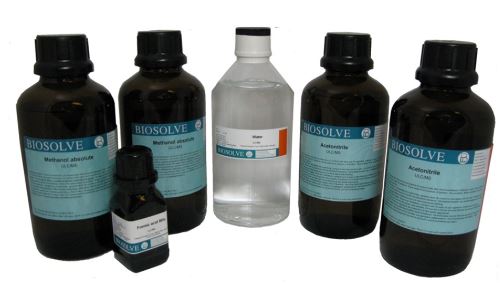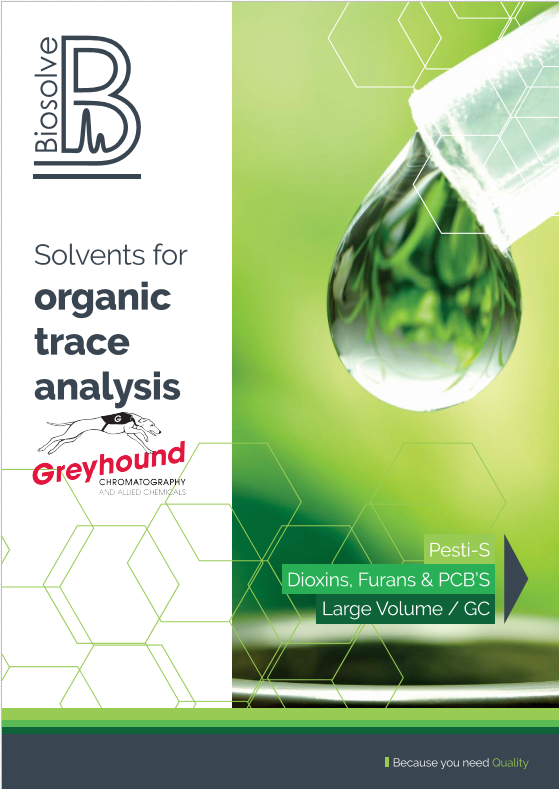 DOWNLOAD PDF
DOWNLOAD PDF
Simulated Rainwater
These are standards that simulate the results of a real sample of a natural matrix. High-Purity Standards initiated these products, beginning with Simulated Rainwater, in 1992. Simulated Rainwater (part numbers SR-1 and SR-2) were designed from research conducted by the National Bureau of Standards (NBS), now NIST, sponsored by the EPA and USGS on acid rain. Our founder, Theodore Rains, participated in this research. This report is based upon his collection of notes and documents from that research that spanned over 10 years.
The goal was to create well-characterized and stable Standard Reference Materials (SRM) to aid in the monitoring of acid rain. It is the pH of the rain that categorizes it as acid rain. Normal rain is defined as having a pH of approximately 5.6. At a pH of 4.6 the rain will have a 10-times increase in acidity, and at 3.6 will have a 100-times acidity. The development of a simulated standard versus the collection of natural rainfall was based upon the need for a stable reference material containing minimal contaminants and unneeded components. The result of the project was the production of SRM 2694 “Simulated Rainwater”. The SRM consisted of four 50 mL solutions at two levels for a total of two bottles at a pH of 4.3 and two bottles at a pH of 3.6.
The first of the reports of the results came out in 1975, Simulated Precipitation Reference Materials, NBSIR 75-958. As this report describes, production of the initial standards was based upon recommendations from the EPA. The first adjustment was to balance the cation and anion concentrations. This adjustment moved the team away from the EPA recommendations. A decision was made to give preference to the cation guidelines. Further complicating the requirements was the goal of preparing a concentrate solution, 50-times the concentration of the final working solution. Lead and copper proved to be unstable at the concentration and pH of the standard. The samples were packaged in glass ampules and stability studies were run. The sodium values were found to increase over time, indicating a leaching from the ampule walls.
The experimentation was repeated in 1977, 1979 and 1982 and reported in Simulated Precipitation Reference Materials II NBSIR 77-1315, III NBSIR 79-1953 and IV NBSIR 82-2581. These studies included a separate reference material for pH, conductivity and acidity to address problems fro the first set of materials with those measurements. They repeated the preparation and analysis with new sets of material as well as conducting stability analysis on the previous sets of reference materials.
By 1984, NBS had developed a Reference Material, RM 8409, for the Simulated Rainwater. By this time the packaging had switched from glass ampules to polyethylene bottles and transition and heavy metals were eliminated. This was as a result of a decision to increase the stability of the material for those components most critical to acid rain studies: pH, acidity, conductance, nitrate, and sulfate. Of these components, the measurement of pH was the primary driving factor. Stability studies of RM 8409 at the eighth month point indicated degradation by a factor of greater than three in the concentration of ammonium.
Standard Reference Material (SRM) 2694 was introduced the following year. As an SRM, it would undergo more extensive testing than an RM, as RM standard only require a single analytical technique for each analyte. The SRM benefited from the studies of the previous standards and reference material. A new analytical method in the Inorganic Analytical Research Division of NBS was utilized for the metals analysis: laser-enhance ionization flame spectrometry. This method complimented by the ICP/FAA/FES methods used in the metals analysis. The ammonium and chloride values were listed on the Certificate of Analysis as reference data, not certified values, due to the stability issues previously observed.
High-Purity Standards has maintained this product as a catalog item since 1992. Unlike SRM 2694, we sell these items as two separate products. SR-1 mimics the Level 1 standard of SRM 2694 and SR-2 that of the Level 2 standard. You can find those items in our Water Standards category on our website and part numbers SR-1 or SR-2. The analytes in these products are traceable to various NIST SRMs. SRM 2694 is currently unavailable from NIST. Other related products to this include standards for pH buffers, conductivity and alkalinity.
Can’t find what you need? Custom standards can still be a very popular method of providing a specific matrix match for your use. To make this option cost effective, consider purchasing a larger quantity or placing a blanket order to lock in your current price and ensure its availability, Email sales@greyhoundchrom.com
Analysing Dioxins, Furans, PCB's ? We have a full range of Reference Standards, Materials and Solvents

Dioxins, Furans, PCB's and many other contaminants are found in the air, in water and contaminated soil. As they accumulate they can become harmful to human health, these contaminants of concern are classed as POPs (Persistent Organic Pollutants), Wellington Laboratories produce Certified Analytical Reference Standards and Materials for testing and analysis, constantly adding to their product portfolio as new contaminents emerge in our environment. Testing to identify these contaminents as they enter our environment through the air, soil and water is a constant battle. Recent media reports have highlighted the dangers to our environment and there are many theories and recommendations as to how we can reduce the impact of contaminents to our planet.
Produced inadvertently by industrial processes such as waste incineration, chemical treatments and manufacturing, Greyhound represents the world's leading manufacturers of Certified Reference Standards and materials, and Organic Trace Solvents which have been developed especially for testing Dioxins, Furans and PCB's.
SPECIAL OFFER – LIMITED STOCK OF DIOXIN AND PCB GRADE BIOSOLVE SOLVENTS
We have a limited stock of Dioxin & PCB Grade Biosolve solvents with a short expiry date (11 months).
Biosolve products are manufactured under strict and detailed operating procedures. The manufacturing plants meet the latest environmental and quality ISO standards, serving as development, production and distribution centres.
From the initial acceptance of selected raw material through process control to the final packed product, all steps are accurately documented. This ensures a high quality of production with lot-to-lot reproducibility and complete traceability for all purposes. Thanks to continual research and development.
Biosolve offers the finest grade Acetonitrile for HPLC & UHPLC available worldwide.

Catalogue Number BIO-08296002
n-Hexane Dioxin & PCB Analysis
4 x 2.5 LTR List Price £223.09
Offer Price £125.00
Catalogue Number BIO-08296002-2
n-Hexane Dioxin & PCB Analysis
2 x 2.5 LTR List Price £125.49
Offer Price £70.00
About Wellington Laboratories
For Over 35 years Wellington Laboratories Inc. has been internationally recognised as a trusted source of high quality reference standard solutions for use in environmental/analytical testing and toxicological research. Wellington Laboratories offers an extensive inventory of individual certified reference standards and solution mixtures of native and mass-labelled halogenated organic compounds including polychlorinated dibenzo-p-dioxins, polychlorinated dibenzofurans, polychlorinated biphenyls, halogenated flame retardants and perfluorinated compounds. Wellington Laboratories also offer a variety of calibration sets and support solutions designed to be used for common regulatory methods or modified in-house methods.
Wellington’s Reference Standards are used mainly in Environmental/analytical testing and toxicological research. Wellington offers an extensive inventory of individual certified reference standards and solution mixtures of native and mass-labelled halogenated organic compounds including polychlorinated dibenzo-p-dioxins, polychlorinated dibenzofurans, polychlorinated biphenyls, halogenated flame retardants and perfluoronated compounds. Wellington also offer a variety of calibration sets and support solutions designed to be used for common regulatory methods of modified in-house methods.
About Biosolve
Biosolve products are manufactured under strict and detailed operating procedures. The manufacturing plants meet the latest environmental and quality ISO standards.
From the initial acceptance of selected raw material through process control to the final packed product, all steps are accurately documented. This ensures a high quality of production with lot-to-lot reproducibility and complete traceability for all purposes. Thanks to continual research and development, Biosolve offer one of the finest grade Acetonitrile for HPLC & UHPLC available worldwide: The Supra-gradient grade and the highest brand ULC/MS grade. Manufacturing and recommended expiry dates are clearly stated on the label whenever relevant. Thanks to the strict policy of quality control, Biosolve are an approved vendor to large health organizations, leading pharmaceutical companies and for the chemical and electronic industries.
With the development of advanced analytical techniques, trace analysis has been a major challenge for analytical chemists.
Analytical chemistry involves the separation, identification and qualification of taget compoun ds in complex samples. Modern chromatographic techniques have excellent separation power. However, due to the increasing requirements of environmental and toxicological regulations the current detection limits cannot meet all needs, therefore, sample enrichment by extraction-concentration technique is frequently required before intrioduction of samples into the chromatographic system. As a result high purity solvents are needed ion the extraction-concentration technique for the analysis of residues, pesticides and other general trace organic contaminants in water, soil food etc.

CONTACT US
Tel: +44 (0) 151 649 4000
Web: www.greyhoundchrom.com
Email: marketing@greyhoundchrom.com
FOLLOW US




YOU MAY ALSO BE INTERESTED IN OUR NEWSLETTER
SIGN UP HERE

CATALOGUE DOWNLOADS





























